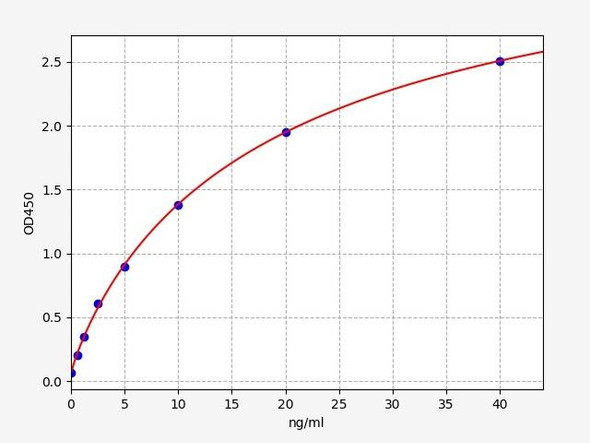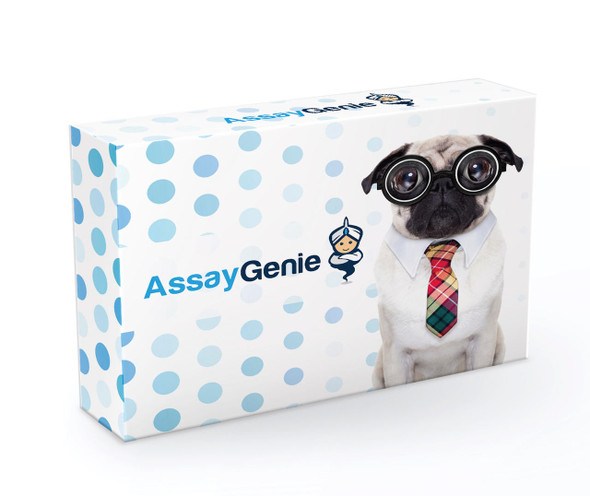Rat MT-CO3 / COX3 ELISA Kit
- SKU:
- RTFI00275
- Product Type:
- ELISA Kit
- Size:
- 96 Assays
- Uniprot:
- P05505
- Sensitivity:
- 0.094ng/ml
- Range:
- 0.156-10ng/ml
- ELISA Type:
- Sandwich
- Synonyms:
- Mtco3, Cytochrome c oxidase polypeptide III
- Reactivity:
- Rat
Description
Rat MT-CO3/COX3 ELISA Kit
The Rat MT-CO3/COX3 ELISA Kit is specifically designed for the sensitive and accurate detection of mitochondrial COX3 (Cytochrome C oxidase subunit 3) and MT-CO3 (Mitochondrially Encoded Cytochrome C Oxidase III) levels in rat samples, including serum, plasma, and tissue homogenates. This kit offers high sensitivity and specificity, ensuring precise and reliable results for a variety of research applications.COX3 and MT-CO3 are essential components of the mitochondrial respiratory chain, playing a crucial role in cellular energy production and metabolism. Changes in their levels can indicate mitochondrial dysfunction, oxidative stress, and various metabolic disorders.
Therefore, this ELISA kit serves as a valuable tool for studying mitochondrial function, oxidative stress, and disease mechanisms in rat models.With its easy-to-use protocol and robust performance, the Rat MT-CO3/COX3 ELISA Kit is a valuable asset for researchers investigating mitochondrial biology, metabolic diseases, and potential therapeutic interventions. Upgrade your research capabilities with this comprehensive kit for precise quantification of COX3 and MT-CO3 levels in rat samples.
| Product Name: | Rat Mtco3 (Cytochrome c oxidase subunit 3) ELISA Kit |
| Product Code: | RTFI00275 |
| Size: | 96 Assays |
| Target: | Rat Mtco3 |
| Alias: | Mtco3, Cytochrome c oxidase polypeptide III |
| Reactivity: | Rat |
| Detection Method: | Sandwich ELISA, Double Antibody |
| Sensitivity: | 0.094ng/ml |
| Range: | 0.156-10ng/ml |
| Storage: | 4°C for 6 months |
| Note: | For Research Use Only |
| Recovery: | Matrices listed below were spiked with certain level of Rat Mtco3 and the recovery rates were calculated by comparing the measured value to the expected amount of Rat Mtco3 in samples. | ||||||||||||||||
| |||||||||||||||||
| Linearity: | The linearity of the kit was assayed by testing samples spiked with appropriate concentration of Rat Mtco3 and their serial dilutions. The results were demonstrated by the percentage of calculated concentration to the expected. | ||||||||||||||||
| |||||||||||||||||
| Intra-Assay: | CV <8% | ||||||||||||||||
| Inter-Assay: | CV <10% |
| Uniprot: | P05505 |
| UniProt Protein Function: | COX3: Subunits I, II and III form the functional core of the enzyme complex. Defects in MT-CO3 are a cause of Leber hereditary optic neuropathy (LHON). LHON is a maternally inherited disease resulting in acute or subacute loss of central vision, due to optic nerve dysfunction. Cardiac conduction defects and neurological defects have also been described in some patients. LHON results from primary mitochondrial DNA mutations affecting the respiratory chain complexes. Defects in MT-CO3 are a cause of mitochondrial complex IV deficiency (MT-C4D); also known as cytochrome c oxidase deficiency. A disorder of the mitochondrial respiratory chain with heterogeneous clinical manifestations, ranging from isolated myopathy to severe multisystem disease affecting several tissues and organs. Features include hypertrophic cardiomyopathy, hepatomegaly and liver dysfunction, hypotonia, muscle weakness, excercise intolerance, developmental delay, delayed motor development and mental retardation. A subset of patients manifest Leigh syndrome. Defects in MT-CO3 are associated with recurrent myoglobinuria mitochondrial (RM-MT). Recurrent myoglobinuria is characterized by recurrent attacks of rhabdomyolysis (necrosis or disintegration of skeletal muscle) associated with muscle pain and weakness, and followed by excretion of myoglobin in the urine. Belongs to the cytochrome c oxidase subunit 3 family. |
| UniProt Protein Details: | Protein type:Oxidoreductase; Mitochondrial; Membrane protein, integral; Membrane protein, multi-pass Cellular Component: mitochondrion; mitochondrial inner membrane; integral to membrane Molecular Function:cytochrome-c oxidase activity Biological Process: aerobic electron transport; respiratory chain complex IV assembly |
| UniProt Code: | P05505 |
| NCBI GenInfo Identifier: | 110189669 |
| NCBI Gene ID: | 7066253 |
| NCBI Accession: | AP_004898.1 |
| Molecular Weight: | 29,871 Da |
| NCBI Full Name: | cytochrome c oxidase subunit III (mitochondrion) |
| NCBI Official Symbol: | COX3 |
| NCBI Protein Information: | cytochrome c oxidase subunit III |
| UniProt Protein Name: | Cytochrome c oxidase subunit 3 |
| UniProt Synonym Protein Names: | Cytochrome c oxidase polypeptide III |
| UniProt Gene Name: | Mtco3 |
| UniProt Entry Name: | COX3_RAT |
| Step | Procedure |
| 1. | Set standard, test sample and control (zero) wells on the pre-coated plate respectively, and then, record their positions. It is recommended to measure each standard and sample in duplicate. Wash plate 2 times before adding standard, sample and control (zero) wells! |
| 2. | Aliquot 0.1ml standard solutions into the standard wells. |
| 3. | Add 0.1 ml of Sample / Standard dilution buffer into the control (zero) well. |
| 4. | Add 0.1 ml of properly diluted sample ( Human serum, plasma, tissue homogenates and other biological fluids.) into test sample wells. |
| 5. | Seal the plate with a cover and incubate at 37°C for 90 min. |
| 6. | Remove the cover and discard the plate content, clap the plate on the absorbent filter papers or other absorbent material. Do NOT let the wells completely dry at any time. Wash plate X2. |
| 7. | Add 0.1 ml of Biotin- detection antibody working solution into the above wells (standard, test sample & zero wells). Add the solution at the bottom of each well without touching the side wall. |
| 8. | Seal the plate with a cover and incubate at 37°C for 60 min. |
| 9. | Remove the cover, and wash plate 3 times with Wash buffer. Let wash buffer rest in wells for 1 min between each wash. |
| 10. | Add 0.1 ml of SABC working solution into each well, cover the plate and incubate at 37°C for 30 min. |
| 11. | Remove the cover and wash plate 5 times with Wash buffer, and each time let the wash buffer stay in the wells for 1-2 min. |
| 12. | Add 90 µL of TMB substrate into each well, cover the plate and incubate at 37°C in dark within 10-20 min. (Note: This incubation time is for reference use only, the optimal time should be determined by end user.) And the shades of blue can be seen in the first 3-4 wells (with most concentrated standard solutions), the other wells show no obvious color. |
| 13. | Add 50 µL of Stop solution into each well and mix thoroughly. The color changes into yellow immediately. |
| 14. | Read the O.D. absorbance at 450 nm in a microplate reader immediately after adding the stop solution. |
When carrying out an ELISA assay it is important to prepare your samples in order to achieve the best possible results. Below we have a list of procedures for the preparation of samples for different sample types.
| Sample Type | Protocol |
| Serum: | If using serum separator tubes, allow samples to clot for 30 minutes at room temperature. Centrifuge for 10 minutes at 1,000x g. Collect the serum fraction and assay promptly or aliquot and store the samples at -80°C. Avoid multiple freeze-thaw cycles. If serum separator tubes are not being used, allow samples to clotovernight at 2-8°C. Centrifuge for 10 minutes at 1,000x g. Removeserum and assay promptly or aliquot and store the samples at-80°C. Avoid multiple freeze-thaw cycles. |
| Plasma: | Collect plasma using EDTA or heparin as an anti-coagulant. Centrifuge samples at 4°C for 15 mins at 1000 × g within 30 mins of collection. Collect the plasma fraction and assay promptly or aliquot and store the samples at -80°C. Avoid multiple freeze-thaw cycles.Note: Over haemolysed samples are not suitable for use with this kit. |
| Urine & Cerebrospinal Fluid: | Collect the urine (mid-stream) in a sterile container, centrifuge for 20 mins at 2000-3000 rpm. Remove supernatant and assay immediately. If any precipitation is detected, repeat the centrifugation step. A similar protocol can be used for cerebrospinal fluid. |
| Cell Culture Supernatant: | Collect the cell culture media by pipette, followed by centrifugation at 4°C for 20 mins at 1500 rpm. Collect the clear supernatant and assay immediately. |
| Cell Lysates: | Solubilize cells in lysis buffer and allow to sit on ice for 30 minutes. Centrifuge tubes at 14,000 x g for 5 minutes to remove insoluble material. Aliquot the supernatant into a new tube and discard the remaining whole cell extract. Quantify total protein concentration using a total protein assay. Assay immediately or aliquot and store at ≤ -20°C. |
| Tissue Homogenates: | The preparation of tissue homogenates will vary depending upon tissue type. Rinse tissue with 1X PBS to remove excess blood & homogenizein 20ml of 1X PBS (including protease inhibitors) and store overnight at ≤ -20°C. Two freeze-thaw cycles are required to break the cell membranes. To further disrupt the cell membranes you can sonicate the samples. Centrifuge homogenates for 5 mins at 5000xg. Remove the supernatant and assay immediately or aliquot and store at -20°C or-80°C. |
| Tissue Lysates: | Rinse tissue with PBS, cut into 1-2 mm pieces, and homogenize with a tissue homogenizer in PBS. Add an equal volume of RIPA buffer containing protease inhibitors and lyse tissues at room temperature for 30 minutes with gentle agitation. Centrifuge to remove debris. Quantify total protein concentration using a total protein assay. Assay immediately or aliquot and store at ≤ -20 °C. |
| Breast Milk: | Collect milk samples and centrifuge at 10,000 x g for 60 min at 4°C. Aliquot the supernatant and assay. For long term use, store samples at -80°C. Minimize freeze/thaw cycles. |









